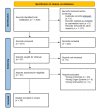The Lasting Effects of COVID-19 on the Progression of Metabolic Dysfunction-Associated Steatotic Liver Disease (MASLD)
- PMID: 37842470
- PMCID: PMC10576539
- DOI: 10.7759/cureus.45231
The Lasting Effects of COVID-19 on the Progression of Metabolic Dysfunction-Associated Steatotic Liver Disease (MASLD)
Abstract
It is estimated that around 30% of the population living in Western countries has metabolic dysfunction-associated steatotic liver disease (MASLD), a spectrum of pathology (not attributed to alcohol/substance intake) initiated by steatosis and progression toward inflammation and irreversible fibrosis metabolic dysfunction-associated steatohepatitis (MASH). With inflammation being a key component of the transition to MASH, it raises the question of whether the ongoing COVID-19 pandemic, which has notoriously induced hyperinflammatory states, may influence the progression of MASLD. Specifically, it remains unclear if the potential chronic sequelae of COVID-19 in patients who recovered from it may increase the predisposition for MASH. Since MASH maintains a high risk for hepatocellular carcinoma, liver failure, and the need for a liver transplant, the potential additive effects of COVID-19 could prove critical to study. Thus, the objective of this study was to conduct a literature review to examine if COVID-19 could have chronic sequelae that affect the progression of MASLD pathogenesis. It was hypothesized that severe cases of COVID-19 could induce systemic inflammation, metabolic changes, and lasting gut microbiome alterations that lead to inflammatory and fibrotic changes in the liver, similar to those seen in MASH. A scoping review of the literature was conducted utilizing the PubMed database. Studies that examined hepatobiliary pathology, gut microbiome, systemic inflammation, metabolic changes, drug-induced liver injury (DILI), and hypoxia seen in COVID-19 were included. Human studies of adult cohorts, animal models, and in vitro experiments were included. Genetic components of MASLD were not examined. Exclusion criteria also encompassed any studies not referencing the hepatobiliary, gastrointestinal tract, portal system, or systemic circulation. Findings indicated a frequent trend of elevated liver enzymes, mild steatosis, Kupffer cell hyperplasia, and hepatobiliary congestion. It was found that direct cytopathic effects on hepatocytes were unlikely, but the direct viral insult of cholangiocytes was a potential complication. High serum levels of IL-1, TNF-a, and MCP-1, in COVID-19 were found as potential risk factors for MASH development. Hypoxia, altered lipid metabolism, and iatrogenic DILI were also proposed as potential precipitators of MASH development. Notably, lasting changes in gut microbiome were also frequently observed and correlated closely with those seen in MASH.
Keywords: covid-19; covid-19 + dili; covid-19 + gut microbiota; hepatobiliary congestion; mash; masld; nafld; nafld pathogenesis; nash; non-alcoholic fatty liver disease.
Copyright © 2023, Backer et al.
Conflict of interest statement
The authors have declared that no competing interests exist.
Figures




Similar articles
-
NAFLD (MASLD)/NASH (MASH): Does It Bother to Label at All? A Comprehensive Narrative Review.Int J Mol Sci. 2024 Aug 2;25(15):8462. doi: 10.3390/ijms25158462. Int J Mol Sci. 2024. PMID: 39126031 Free PMC article. Review.
-
Systemic impacts of metabolic dysfunction-associated steatotic liver disease (MASLD) and metabolic dysfunction-associated steatohepatitis (MASH) on heart, muscle, and kidney related diseases.Front Cell Dev Biol. 2024 Jul 16;12:1433857. doi: 10.3389/fcell.2024.1433857. eCollection 2024. Front Cell Dev Biol. 2024. PMID: 39086662 Free PMC article. Review.
-
Hepatic angiotensin-converting enzyme 2 expression in metabolic dysfunction-associated steatotic liver disease and in patients with fatal COVID-19.World J Gastroenterol. 2024 Aug 21;30(31):3705-3716. doi: 10.3748/wjg.v30.i31.3705. World J Gastroenterol. 2024. PMID: 39192998 Free PMC article.
-
Sex-based differences in natural killer T cell-mediated protection against diet-induced steatohepatitis in Balb/c mice.Biol Sex Differ. 2023 Nov 14;14(1):85. doi: 10.1186/s13293-023-00569-w. Biol Sex Differ. 2023. PMID: 37964320 Free PMC article.
-
Histidine-rich glycoprotein in metabolic dysfunction-associated steatohepatitis-related disease progression and liver carcinogenesis.Front Immunol. 2024 Feb 26;15:1342404. doi: 10.3389/fimmu.2024.1342404. eCollection 2024. Front Immunol. 2024. PMID: 38469298 Free PMC article.
Cited by
-
Effect of Socialization on Alzheimer's Disease During the COVID-19 Pandemic.Cureus. 2024 Aug 15;16(8):e66942. doi: 10.7759/cureus.66942. eCollection 2024 Aug. Cureus. 2024. PMID: 39280361 Free PMC article. Review.
-
Impact of non-alcoholic fatty liver disease on coronavirus disease 2019: A systematic review.World J Hepatol. 2024 Aug 27;16(8):1185-1198. doi: 10.4254/wjh.v16.i8.1185. World J Hepatol. 2024. PMID: 39221098 Free PMC article.
-
Nutritional and Wellness Strategies for Neurological and Psychiatric Recovery From Post-COVID Syndrome and Post-acute Sequelae of COVID-19.Cureus. 2023 Dec 25;15(12):e51076. doi: 10.7759/cureus.51076. eCollection 2023 Dec. Cureus. 2023. PMID: 38269219 Free PMC article. Review.
-
COVID-19 and Its Ophthalmic Manifestations: A Literature Review.Cureus. 2024 Mar 5;16(3):e55571. doi: 10.7759/cureus.55571. eCollection 2024 Mar. Cureus. 2024. PMID: 38576676 Free PMC article. Review.
-
Neurological Complications of COVID-19 Infection: A Comprehensive Review.Cureus. 2024 Jul 23;16(7):e65192. doi: 10.7759/cureus.65192. eCollection 2024 Jul. Cureus. 2024. PMID: 39176347 Free PMC article. Review.
References
Publication types
LinkOut - more resources
Full Text Sources
Miscellaneous
